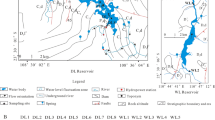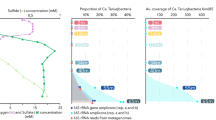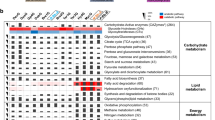Abstract
Previous studies indicate that lysogeny is preponderant when environmental conditions are challenging for the bacterial communities and when their metabolism is reduced. Furthermore, it appears that lysogeny is more frequent within certain bacterial phylogenetic groups. In this comparative study from 10 freshwater reservoirs and 10 coastal lagoons, we aim to disentangle the influence of these different factors. In eight reservoirs and four lagoons, lysogeny was detected by induction assays with mitomycin C, and induction significantly modified the bacterial community composition (BCC), whereas community composition remained constant in ecosystems in which lysogeny was not observed. Among the phylogenetic groups studied, the most abundant ones were Bacteroidetes and α-proteobacteria in lagoons, and β-proteobacteria and Bacteroidetes in reservoirs. These dominant groups comprised the highest proportions of inducible lysogens. In order to unravel the effects of bacterial metabolism from phylogeny on lysogeny, we measured bacterial community physiology and the specific activities of selected phylogenetic groups. The proportion of inducible lysogens within the α- and the β-proteobacteria decreased with increasing group-specific metabolism in lagoons and reservoirs, respectively. In contrast, this relationship was not observed for the other lysogen-containing groups. Hence, both host physiology and phylogeny are critical for the establishment of lysogeny. This study illustrates the importance of lysogeny among the most abundant phylogenetic groups, and further suggests its strong structuring impact on BCC.
Similar content being viewed by others
Log in or create a free account to read this content
Gain free access to this article, as well as selected content from this journal and more on nature.com
or
References
Ackermann HW, DuBow MS . (1987). Viruses of Prokaryotes: General Properties of Bacteriophages. CRC Press, Inc.: Boca Raton, Florida.
Alonso C, Pernthaler J . (2005). Incorporation of glucose under anoxic conditions by bacterioplankton from coastal North Sea surface waters. Appl Environ Microbiol 71: 1709–1716.
Alonso-Saez L, Balague V, Sa EL, Sanchez O, Gonzalez JM, Pinhassi J et al. (2007). Seasonality in bacterial diversity in north-west Mediterranean coastal waters: assessment through clone libraries, fingerprinting and FISH. FEMS Microbiol Ecol 60: 98–112.
Amann R, Fuchs BM . (2008). Single-cell identification in microbial communities by improved fluorescence in situ hybridization techniques. Nature Rev Microbiol 6: 339–348.
Arutyunyan R, Gebhart E, Hovhannisyan G, Greulich KO, Rapp A . (2004). Comet-FISH using peptide nucleic acid probes detects telomeric repeats in DNA damaged by bleomycin and mitomycin C proportional to general DNA damage. Mutagenesis 19: 403–408.
Bec B . (2005). Dynamique du picophytoplancton dans les lagunes Mediterraneennes du Languedoc-Roussillon et de Corse. Ph-D, Université de Toulouse III.
Benlloch S, Rodríguez-Valera F, Martinez-Murcia AJ . (1996). Bacterial diversity in two coastal lagoons deduced from 16S rDNA PCR amplification and partial sequencing. FEMS Microbiol Ecol 18: 267–280.
Bettarel Y, Arfi R, Bouvier T, Bouvy M, Briand E, Colombet J et al. (2008). Virioplankton distribution and activity in a tropical eutrophicated Bay. Estuar Coast Shelf Sci 80: 425–429.
Borcard D, Legendre P, Drapeau P . (1992). Partialling out the spatial component of ecological variation. Ecology 73: 1045–1055.
Bouvier T, del Giorgio PA . (2007). Key role of selective viral-induced mortality in determining marine bacterial community composition. Environ Microbiol 9: 287–297.
Bouvier T, del Giorgio PA . (2003). Factors influencing the detection of bacterial cells using fluorescence in situ hybridization (FISH): A quantitative review of published reports. FEMS Microbiol Ecol 44: 3–15.
Bühring SI, Elvert M, Witte U . (2005). The microbial community structure of different permeable sandy sediments characterized by the investigation of bacterial fatty acids and fluorescence in situ hybridization. Environ Microbiol 7: 281–293.
Burnham KP, Anderson DR . (2002). Model Selection and Multi-Model Inference: a Practical Information–Theoretic Approach. Springer, New York, NY.
Brüssow H, Canchaya C, Hardt WD . (2004). Phages and the evolution of bacterial pathogens: From genomic rearrangements to lysogenic conversion. Microbiol Mol Biol Rev 68: 560–602.
Casjens S . (2003). Prophages and bacterial genomic: what have we learned so far? Mol Microbiol 49: 277–300.
Casjens S, Hendrix RW . (2005). Bacteriophages and the bacterial genome. In Higgins PN (ed). Bacterial chromosome. ASM Press: Washington DC, pp. 39–53.
Chen F, Lu JR, Binder BJ, Liu YC, Hodson RE . (2001). Application of digital image analysis and flow cytometry to enumerate marine viruses stained with SYBR gold. Appl Environ Microbiol 67: 539–545.
Cochran PK, Paul JH . (1998). Seasonal abundance of lysogenic bacteria in a subtropical estuary. Appl Environ Microbiol 64: 2308–2312.
Cottrell MT, Kirchman DL . (2000). Natural assemblages of marine proteobacteria and members of the Cytophaga-Flavobacter cluster consuming low- and high-molecular-weight dissolved organic matter. Appl Environ Microbiol 66: 1692–1697.
de Wit R . (2008). Microbial diversity in the Bassin d'Arcachon coastal lagoon. Hydrobiologia 611: 5–15.
del Giorgio PA, Bird DF, Prairie YT, Planas D . (1996). Flow cytometric determination of bacterial abundance in lake plankton with the green nucleic acid stain SYTO 13. Limnol Oceanogr 41: 783–789.
del Giorgio PA, Gasol JM . (2008). Physiological structure and single-cell activity in marine bacterioplankton. In Kirchman DL (ed). Microbial ecology of the oceans 2nd edn. Wiley-Blackwell, pp 243–285.
Edlin G, Lin L, Bitner R . (1975). Lambda lysogens of Escherichia coli reproduce more rapidly than non-lysogens. Nature 255: 735–737.
Fuchs BM, Zubkov MV, Sahm K, Burkill PH, Amann R . (2000). Changes in community composition during dilution cultures of marine bacterioplankton as assessed by flow cytometric and molecular biological techniques. Environ Microbiol 2: 191–201.
Fuhrman JA . (1999). Marine viruses and their biogeochemical and ecological effects. Nature 399: 541–548.
Glöckner FO, Fuchs BM, Amann R . (1999). Bacterioplankton compositions of lakes and oceans: a first comparison based on fluorescence in situ hybridization. Appl Environ Microbiol 65: 3721–3726.
Gottesman M, Oppenheim AB . (1994). Lysogeny and prophage. In Webster R G, Granoff A(eds). Encyclopedia of virology. Academic press: San Diego, CA, USA, pp. 814–823.
Hewson I, Fuhrman JA . (2007). Characterization of Lysogens in Bacterioplankton Assemblages of the Southern California Borderland. Microb Ecol 53: 631–638.
Iyer VN, Syzbalski W . (1963). A molecular mechanism of Mitomycin action: linking of complementary DNA strands. Proc Natl Acad Sci USA 50: 355–362.
Jiang SC, Paul JH . (1996). Occurrence of lysogenic bacteria in marine microbial communities as determined by prophage induction. Mar Ecol Prog Ser 142: 27–38.
Kirchman DL, K'Nees E, Hodson RE . (1985). Leucine incorporation and its potential as a measure of protein synthesis by bacteria in natural aquatic systems. Appl Environ Microbiol 49: 599–607.
Legendre P, Legendre L . (1998). Numerical Ecology 2nd edn. Elvesier: Amsterdam, Netherlands.
Levin BR, Lenski RE . (1983). Coevolution in bacteria and their viruses and plasmids. In Futuyma DJ, Slatkin M (eds). Coevolution. Sinauer, Sunderland, MA, USA. pp. 99–127.
Long A, McDaniel LD, Mobberley J, Paul JH . (2008). Comparison of lysogeny (prophage induction) in heterotrophic bacterial and Synechococcus populations in the Gulf of Mexico and Mississippi river plume. ISME J 2: 132–144.
Marsh P, Wellington E . (1994). Phage–host interactions in soil. FEMS Microbiol Ecol 15: 99–108.
McDaniel LD, Houchin L, Williamson S, Paul JH . (2002). Plankton blooms: Lysogeny in marine Synechococcus. Nature 415: 496.
Menzel DW, Corwin N . (1965). The measurement of total phosphorus in seawater based on the liberation of organically bound fractions by persulfate oxidation. Limnol Oceanogr 10: 280–282.
Middelboe M, Hagström A, Blackburn N, Sinn B, Fischer U, Borch NH et al. (2001). Effects of Bacteriophages on the Population Dynamics of Four Strains of Pelagic Marine Bacteria. Microb Ecol 42: 395–406.
Middelboe M, Holmfeldt K, Riemann L, Nybroe O, Haaber J . (2009). Bacteriophages drive strain diversification in a marine Flavobacterium : implications for phage resistance and physiological properties. Environ Microbiol 11: 1971–1982.
Morris RM, Rappé MS, Connon SA, Vergin KL, Siebold WA, Carlson CA et al. (2002). SAR11 clade dominates ocean surface bacterioplankton communities. Nature 420: 806–810.
Parada V, Herndl GJ, Weinbauer MG . (2006). Viral burst size of heterotrophic prokaryotes in aquatic systems. J Mar Biol Ass UK 86: 613–621.
Paul JH . (2008). Prophages in marine bacteria : dangerous molecular time-bombs or the key to survival in the seas? ISME J 2: 579–589.
Peres-Neto P, Legendre P, Dray S, Borcard D . (2006). Variation partioning of species data matrices: estimation and comparison of fractions. Ecology 87: 2614–2625.
Pernthaler A, Pernthaler J, Amann R . (2004). Sensitive multi-color fluorescence in situ hybridization for the identification of environmental microorganisms. Molecular microbial ecology manual 2nd edn. 3. Academic publishers: Kluwer, pp 711–726.
Pradeep Ram AS, Sime-Ngando T . (2009). Resources drive trades-off between viral lifestyles in the plankton: evidence from freshwater microbial microcosms. Environ Microbiol 12: 467–479.
Raimbault P, Slawyk G . (1991). A semiautomatic, wet oxidation method for the determination of particulate organic nitrogen collected on filters. Limnol Oceanogr 36: 405–408.
Rappé MS, Vergin K, Giovannoni SJ . (2000). Phylogenetic comparisons of a coastal bacterioplankton community with its counterparts in open ocean and freshwater systems. FEMS Microbiol Ecol 33: 219–232.
Rohwer F, Vega Thurber R . (2009). Viruses manipulate the marine environment. Nature 459: 207–212.
Salcher MM, Hofer J, Hornak K, Jezbera J, Sonntag B, Vrba J et al. (2007). Modulation of microbial predator-prey dynamics by phosphorus availability: Growth patterns and survival strategies of bacterial phylogenetic clades. FEMS Microbiol Ecol 60: 40–50.
Sherr BF, del Giorgio P, Sherr EB . (1999). Estimating abundance and single-cell characteristics of respiring bacteria via the redox dye CTC. Aquat Microb Ecol 18: 117–131.
Shkilnyj P, Koudelka GB . (2007). Effect of salt shock on stability of λimm434 lysogens. Appl Environ Microbiol 189: 3115–3123.
Simek K, Pernthaler J, Weinbauer MG, Hornak K, Dolan JR, Nedoma J et al. (2001). Changes in bacterial community composition and dynamics and viral mortality rates associated with enhanced flagellate grazing in a mesoeutrophic reservoir. Appl Environ Microbiol 67: 2723–2733.
Srividhya KV, Alaguraj V, Poornima G, Kumar D, Singh GP, Raghavenderan L et al. (2007). Identification of Prophages in Bacterial Genomes by Dinucleotide Relative Abundance Difference. PLoS ONE 2: e1193.
Surrallés J, Catalán J, Creus A, Norppa H, Xamena N, Marcos R . (1995). Micronuclei induced by alachlor, mitomycin-C and vinblastine in human lymphocytes: presence of centromeres and kinetochores and influence of staining techniques. Mutagenesis 10: 417–423.
Suttle CA . (2007). Marine viruses-major players in the global ecosystem. Nat Rev Microbiol 5: 801–812.
Tapper MA, Hicks RE . (1998). Temperate viruses and lysogeny in Lake Superior bacterioplankton. Limnol Oceanogr 43: 95–103.
Thingstad TF, Lignell R . (1997). Theoretical models for the control of bacterial growth rate, abundance, diversity and carbon demand. Aquat Microb Ecol 13: 19–27.
Tripp HJ, Kitner JB, Schwalbach MS, Dacey JWH, Wilhelm LJ, Giovannoni SJ . (2008). SAR11 marine bacteria require exogenous reduced sulphur for growth. Nature 452: 741–744.
Weinbauer MG . (2004). Ecology of prokaryotic viruses. FEMS Microbiol Rev 28: 127–181.
Weinbauer MG, Brettar I, Hofle MG . (2003). Lysogeny and virus-induced mortality of bacterioplankton in surface, deep, and anoxic marine waters. Limnol Oceanogr 48: 1457–1465.
Weinbauer MG, Suttle CA . (1999). Lysogeny and prophage induction in coastal and offshore bacterial communities. Aquat Microb Ecol 18: 217–225.
Windholz M, Budavari S, Stroumtsos LY, Fertig MN . (1976). The Merck index: an encyclopedia of chemicals and drugs. In . Rahway NJ (ed), 9th edn. Merck & Co. pp 766–767.
Winter C, Bouvier T, Weinbauer MG, Thingstad TF . (2010). The ‘killing the winner’ hypothesis revisited- trade-offs between competition and defense specialists in unicellular planktonic organisms. Microbiol Mol Biol Rev 74: 42–57.
Yensch CS, Menzel DW . (1963). A method for determination of phytoplankton chlorophyll and pheophytin by fluorescence. Deep Sea Res 10: 221–231.
Yokokawa T, Nagata T, Cottrell MT, Kirchman DL . (2004). Growth rate of the major phylogenetic bacterial groups in the Delaware estuary. Limnol Oceanogr 49: 1620–1629.
Zubkov MV, Fuchs BM, Burkill PH, Amann R . (2001). Comparison of cellular and biomass specific activities of dominant bacterioplankton groups in stratified waters of the Celtic Sea. Appl Environ Microbiol 67: 5210–5218.
Acknowledgements
The authors thank Dr J Gasol for his laboratory facilities and expertise on the MAR-FISH method. Nitrogen and phosphorus analyses were made possible by the help of Dr D Munaron and G Messiaen from the Ifremer (Sète) laboratory. We thank Dr E Rochelle-Newall for the technical advice on the Chl a analyses, and M Agis for valuable experimental help. This work was supported by the French ANR Aquaphage 07 BDIV 015–02 (to TB and YB). Work of HS was supported by the Spanish MEC (SB2006–0060), MCyI (Juan de la Cierva Fellowship JCI-2008–2727) and Portuguese FCT do Ministério da Ciência, Tecnologia e Ensino Superior' (Grant SFRH/BPD/34041/2006). This paper was made in partial fulfillment of the requirements for a PhD degree from the Université de Montpellier 2 by CFM, who acknowledges a fellowship from the French Ministry of Higher Education and Research (MESR).
Author information
Authors and Affiliations
Corresponding author
Rights and permissions
About this article
Cite this article
Maurice, C., Mouillot, D., Bettarel, Y. et al. Disentangling the relative influence of bacterioplankton phylogeny and metabolism on lysogeny in reservoirs and lagoons. ISME J 5, 831–842 (2011). https://doi.org/10.1038/ismej.2010.181
Received:
Revised:
Accepted:
Published:
Issue date:
DOI: https://doi.org/10.1038/ismej.2010.181
Keywords
This article is cited by
-
Temporal dynamics of uncultured viruses: a new dimension in viral diversity
The ISME Journal (2018)
-
Variability and host density independence in inductions-based estimates of environmental lysogeny
Nature Microbiology (2017)
-
Lytic to temperate switching of viral communities
Nature (2016)
-
Counts and sequences, observations that continue to change our understanding of viruses in nature
Journal of Microbiology (2015)
-
New paradigms in tropical limnology: the importance of the microbial food web
Hydrobiologia (2012)



